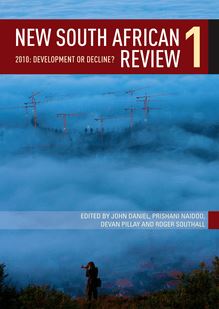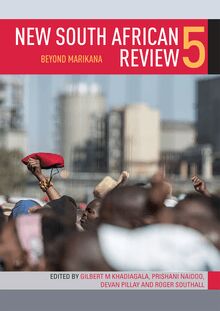New South African Review 6 , livre ebook
188
pages
English
Ebooks
2018
Vous pourrez modifier la taille du texte de cet ouvrage
Obtenez un accès à la bibliothèque pour le consulter en ligne En savoir plus
Découvre YouScribe en t'inscrivant gratuitement
Découvre YouScribe en t'inscrivant gratuitement
188
pages
English
Ebooks
2018
Vous pourrez modifier la taille du texte de cet ouvrage
Obtenez un accès à la bibliothèque pour le consulter en ligne En savoir plus
Publié par
Date de parution
29 janvier 2018
Nombre de lectures
0
EAN13
9781776140992
Langue
English
Poids de l'ouvrage
3 Mo
IINTRODUCTION
The global crisis of inequality and its South African manifestations Devan Pillay
PART ONE: INEQUALITY AND CLASS: POLARITIES AND POLICIES
CHAPTER 1 Inequality in South Africa Neva Makgetla
CHAPTER 2 A national minimum wage in South Africa: A tool to reduce inequality? - Jana Mudronova and Gilad Isaacs
CHAPTER 3 The politics of poverty and inequality in South Africa: Connectivity, abjections and the problem of measurement - Sarah Bracking
CHAPTER 4 The financialisation of the poor and the reproduction of inequality - David Neves
PART TWO: THE POLITICS OF INEQUALITY
CHAPTER 5 Liberal democracy, inequality and the imperatives of alternative politics: Nigeria and South Africa - Samuel Oloruntoba
CHAPTER 6 Liberalism and anti-liberalism in South Africa. Or, is an egalitarian liberalism possible? - Daryl Glaser
CHAPTER 7 Equality and inequality in South Africa. What do we actually want? And how do we get it? - Roger Southall
PART THREE: SOCIAL DIMENSIONS OF INEQUALITY
CHAPTER 8 Analysis must rise: A political economy of falling fees - Stephanie Allais
CHAPTER 9 Education, the state and class inequality: The case for free higher education in South Africa - Enver Motala, Salim Vally and Rasigan Maharajh
CHAPTER 10 Still waiting: The South African government’s pending promise of equality for people with disabilities - Jacqui Ala and David Black
CHAPTER 11 Big fish in small ponds: Changing stratification and inequalities in small towns in the Karoo region, South Africa - Doreen Atkinson
PART FOUR: LAND AND ENVIRONMENT
CHAPTER 12 Spatial defragmentation in rural South Africa: A prognosis of agrarian reforms - Samuel Kariuki
CHAPTER 13 Mining, rural struggles and inequality on the platinum belt, South Africa - Sonwabile Mnwana
CHAPTER 14 Challenging environmental injustice and inequality in contemporary South Africa - Jacklyn Cock
CHAPTER 15 The geography of nuclear power, class and inequality in South Africa - Jo-Ansie van Wyk
Publié par
Date de parution
29 janvier 2018
Nombre de lectures
0
EAN13
9781776140992
Langue
English
Poids de l'ouvrage
3 Mo
Published in South Africa by:
Wits University Press
1 Jan Smuts Avenue
Johannesburg 2001
www.witspress.co.za
Published edition Wits University Press 2018
Compilation Edition editors 2018
Chapters Individual contributors 2018
Cover photograph: Bloubosrand Kya Sands Johnny Miller
First published 2018
http://dx.doi.org.10.18772/22018010558
ISBN 978-1-77614-055-8 (Print)
ISBN 978-1-77614-098-5 (PDF)
ISBN 978-1-77614-099-2 (EPUB)
All rights reserved. No part of this publication may be reproduced, stored in a retrieval system, or transmitted in any form or by any means, electronic, mechanical, photocopying, recording or otherwise, without the written permission of the publisher, except in accordance with the provisions of the Copyright Act, Act 98 of 1978.
Edited by Monica Seeber
Project managed by Hazel Cuthbertson
Indexed by Miri van Rooyen
Cover designed by Hothouse South Africa
Typeset by MPS
Contents
List of tables and figures
INTRODUCTION: The global crisis of inequality and its South African manifestations
Devan Pillay
PART 1: INEQUALITY AND CLASS: POLARITIES AND POLICIES
CHAPTER 1: Inequality in South Africa
Neva Makgetla
CHAPTER 2: A national minimum wage in South Africa: A tool to reduce inequality?
Jana Mudronova and Gilad Isaacs
CHAPTER 3: The politics of poverty and inequality in South Africa: Connectivity, abjections and the problem of measurement
Sarah Bracking
CHAPTER 4: The financialisation of the poor and the reproduction of inequality
David Neves
PART 2: THE POLITICS OF INEQUALITY
CHAPTER 5: Liberal democracy, inequality and the imperatives of alternative politics: Nigeria and South Africa
Samuel Ojo Oloruntoba
CHAPTER 6: Liberalism and anti-liberalism in South Africa. Or, is an egalitarian liberalism possible?
Daryl Glaser
CHAPTER 7: Equality and inequality in South Africa: What do we actually want? And how do we get it?
Roger Southall
PART 3: SOCIAL DIMENSIONS OF INEQUALITY
CHAPTER 8: Analysis must rise: A political economy of falling fees
Stephanie Allais
CHAPTER 9: Education, the state and class inequality: The case for free higher education in South Africa
Enver Motala, Salim Vally and Rasigan Maharajh
CHAPTER 10: Still waiting: The South African government’s pending promise of equality for people with disabilities
Jacqui Ala and David Black
CHAPTER 11: Big fish in small ponds: Changing stratification and inequalities in small towns in the Karoo region, South Africa
Doreen Atkinson
PART 4: LAND AND ENVIRONMENT
CHAPTER 12: Spatial defragmentation in rural South Africa: A prognosis of agrarian reforms
Samuel Kariuki
CHAPTER 13: Mining, rural struggles and inequality on the platinum belt
Sonwabile Mnwana
CHAPTER 14: Challenging environmental injustice and inequality in contemporary South Africa
Jacklyn Cock
CHAPTER 15: The geography of nuclear power, class and inequality
Jo-Ansie van Wyk
Contributors
Index
List of tables and figures
TABLES
CHAPTER 2 Table 2.1: Summary of South African studies
Table 2.2: Percentage point increase in key variables relative to baseline by 2025
CHAPTER 10 Table 10.1: Percentage of disabled learners not attending education facilities, disaggregated by type and extent of disability as well as age group
Table 10.2: Disabled people employed as percentage of the South African labour force disaggregated by level of representation and gender
CHAPTER 15 Table 15.1: Selected South African nuclear geographies, ca. 2017
Table 15.2: Dimensions and indicators of South Africa’s nuclear geography
Table 15.3: Socio-economic indicators of selected nuclear host communities
FIGURES
CHAPTER 1 Figure 1.1: Working age population, employment and top earnings decile by race and gender, 2015
Figure 1.2: Share of woman-headed households compared to share of employed and non-working age people by household income decile, 2015
Figure 1.3: Median household income in former ‘homeland’ and other regions, by province, 2015
Figure 1.4: Share of households in former ‘homeland’ regions by decile, 2015
Figure 1.5: Household income sources by decile, 2015 (share of households reporting any income from each source)
Figure 1.6: Average number of employed people per household and share of total employment by household income decile, 2015
Figure 1.7: Share of working age adults employed, by sector, education, race and gender, 2015
Figure 1.8: Median monthly wage or salary by race, gender, age group and education, 2015
Figure 1.9: Share of employers in total employment by decile, 2015
Figure 1.10: Share of different kinds of earned income by income groups for people with income-generating employment, 2015
Figure 1.11: Earnings by source and income group for people with paid employment, 2015
Figure 1.12: Share of employers and working age population by race and median earnings of employers, 2015
Figure 1.13: Fees paid by household income level and type of education, 2015
Figure 1.14: Attendance by type of educational institution and income level, 2015
Figure 1.15: Percentage of women and men who said they had received a cash transfer from the government in the preceding year in upper middle-income economies, 2014
Figure 1.16: Number of people receiving grants per thousand households by household income quintile, 2015
Figure 1.17: Estimated income from social grants per quintile, as percentage of median income per quintile and in rands, 2015
Figure 1.18: Municipal services by household income group, 2015
Figure 1.19: Housing by type and by race, 1996, 2011, 2016
Figure 1.20: Access to municipal infrastructure by race, 1996 to 2016
Figure 1.21: Estimated population growth by province, 1996 to 2016
Figure 1.22: Government spending as percentage of GDP, South Africa, Brazil and other upper middle-income economies (a)
Figure 1.23: Fiscal trends, 2008/2009 to 2015/2016 and projected for 2016/2017 to 2018/2019
CHAPTER 2 Figure 2.1: Labour share in South Africa (1990–2016)
Figure 2.2: National minimum wages and inequality in four Latin American countries (2000–2012)
Figure 2.3: Compliance rate in selected developing countries
Figure 2.4: Real wage growth for sectoral determinations (2002–2015)
Figure 2.5: Percentage increase in hourly sectoral determinations between institutions, 2015
Figure 2.6: Average real wages (2025) and average annual growth rate of household income (2016–2025)
Figure 2.7: Macroeconomic impacts
Figure 2.8: Impact on poverty and inequality
CHAPTER 10 Figure 10.1: Disabled people employed by job sector as a percentage of the entire labour force
CHAPTER 15 Figure 15.1: South Africa’s nuclear geography
INTRODUCTION
The global crisis of inequality and its South African manifestations
Devan Pillay
We are, once again, in world history, approaching an age of extremes, as the global crisis of accumulation approaches its social and ecological limits, generating huge inequalities last seen in the nineteenth century ( Piketty 2014 ). This has resulted in increasing crises of political legitimacy in various countries and regions; the rise of populist leaders such as Donald Trump, the new president of the USA; and the decision by British voters (by a small majority) to leave the European Union. To a large extent the Right had successfully blamed immigration for rising unemployment, eclipsing the Left s traditional focus on class inequality with a stronger emotional appeal of identity politics - in particular race, ethnicity and/or religion. The rise of religious fundamentalism - whether Christian, Hindu, Buddhist or Islamic - has reached alarming proportions in parts of the world. However, while recent elections in other major developed countries such as France and Germany reveal a rise in support for anti-immigration (and, indeed, neofascist) parties, a class politics seems to have resonance, particularly among younger voters. The Left has seen increased support in countries like Greece and Spain, and in the rise of Bernie Sanders in the USA, as well as Jeremy Corbyn as leader of the UK Labour Party.
South Africa is a microcosm, with its own unique features, of this global socio-economic and political crisis. Our colonial-apartheid past generated distinct racialised and gendered forms of inequality and poverty, but a rising black elite since 1994 reveals that at a fundamental level inequality is based on class conflict - namely, the determination of the rich and powerful to maintain their privileges, against the struggles of the poor and excluded to obtain a share of the social surplus. The characterisation of our political economy as one that is dominated by white monopoly capital is analytically weak in that it directs social inquiry, politics and policy towards the racial content of capital and class domination, rather than class domination itself. Indeed, politically charged assertions about white monopoly capitalism are inclined to exaggerate the extent of white control of the economy, and downplay increased black participation. President Jacob Zuma s assertion that only 3 per cent of the Johannesburg Stock Exchange (JSE) is owned by black people, contradicts research commissioned by the JSE in December 2013 that black people own 23 per cent of the Top 100 companies listed; white South Africans own 22 per cent; foreign investors hold about 39 per cent of shares on the JSE, with a further 16 per cent an unclear mix of shareholder demographics ( Hogg 2015 ). While exact ownership figures remain an issue of dispute, few would disagree that ownership of shares does not necessarily translate into control of companies, and this requires further research. The 3 per cent is nevertheless repeatedly cited on the ANN7 TV channel owned by the Gupta family, who have been waging a fight-back against charges that, through the president, they have been trying to capture the state.
In other words, if white monopoly capitalism is the problem, is b





